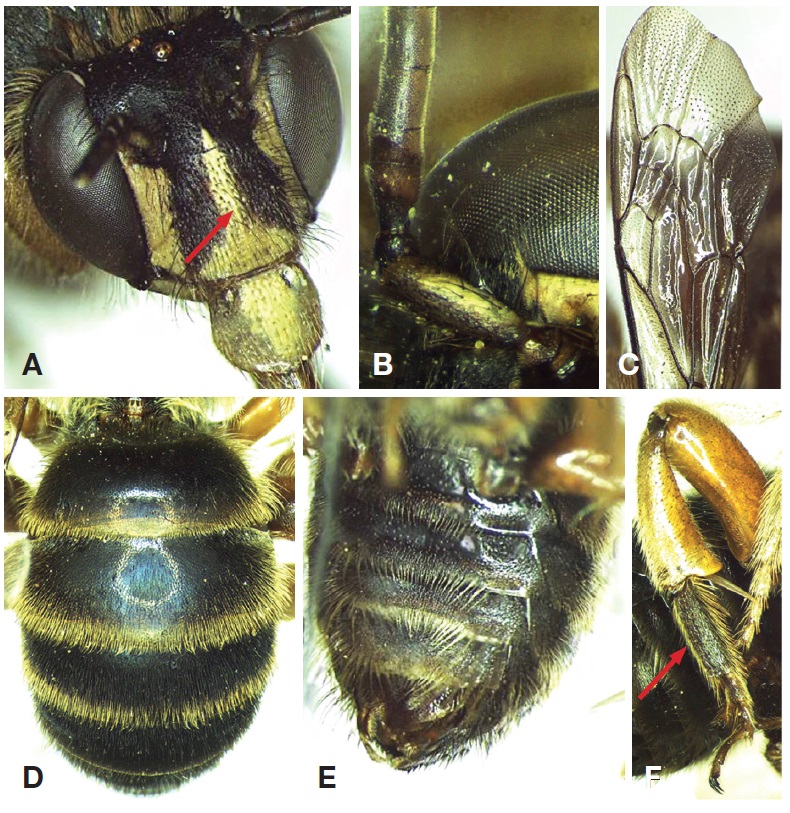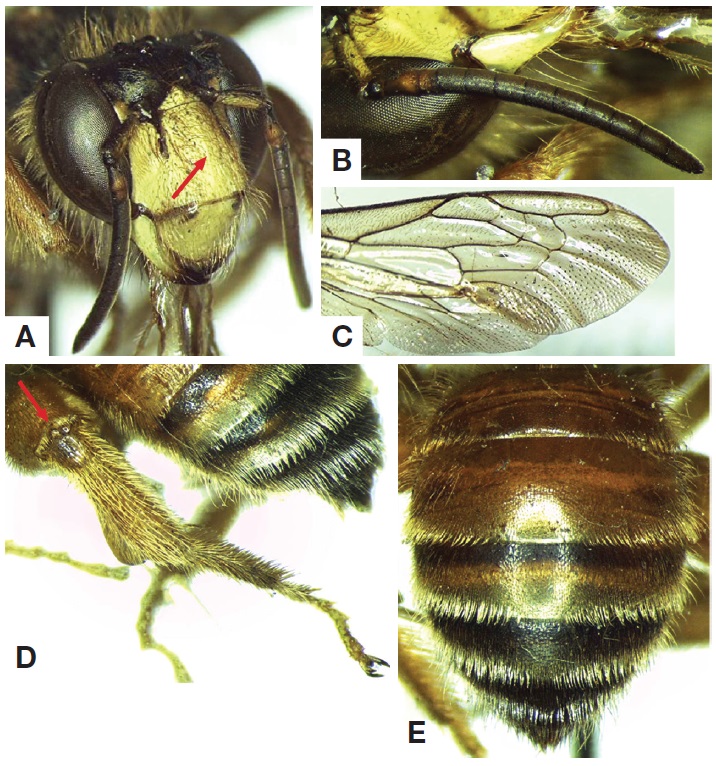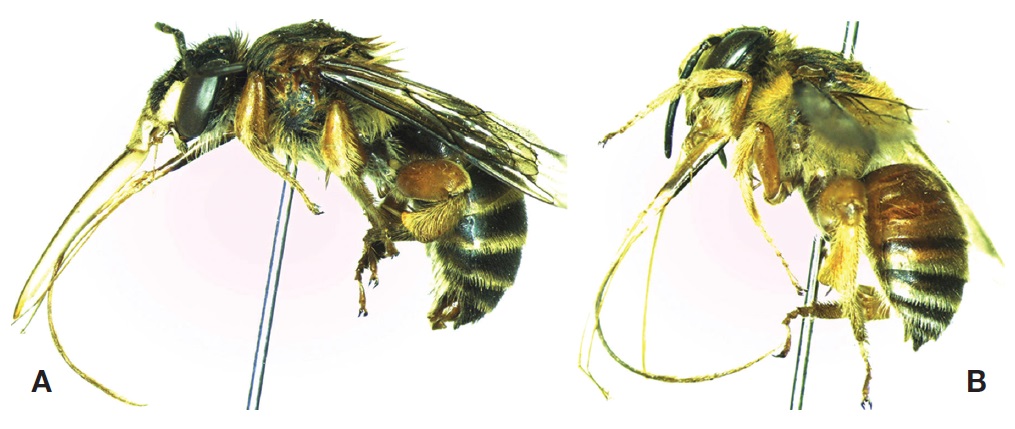



The genus
In Vietnam, two nationwide-faunistic of the family Apidae have been published, namely Le (2008) and Khuat et al. (2012), listing 41 and 35 species occurring in the country and northern part of the country respectively. There, however, was no record of the genus
The material examined in the present study is deposited in the collections of the IEBR, Hanoi, Vietnam. Morphological and color characters of the pinned and dried specimens were observed under a stereoscopic dissecting microscope. Body length refers the length of head, mesosoma and first two metasomal segments combined.
Photographic images were made with the Leica M80 Stereo Microscope, using LAS exclusive microscopy software (LAS EZ 3.1.1); the plates were edited with Photoshop CS6.
Morphological terminology follows Michener (2007).
Diagnosis. Diagnosis for the genus
As remarked by Lieftinck (1966), the species of the genus
>
Elaphropoda percarinata
This species has been recorded from China (Xizang, Sichuan, Yunnan, Hunnan, Guangxi Zhuang), Taiwan, and Vietnam (Ascher and Pickering, 2014). In Vietnam, this species was recorded by Ascher and Pickering (2014) based on one female collected in Ha Tinh (17 km south-east Huong Son, 18°36′66.6″N, 105°21′66.6″E, 180 m, 19-23 Apr 1998, Carpenter JM).
Material examined. Bac Kan: 1 male, Kim Hy natural reserve, An Tinh, Na Ri, 22°12′31″N, 106°5′2″E, 3 Jun 2014, Nguyen LTP, Nguyen DD, Tran DD.
The male of this species was described by Cockerell in 1930. In this study, the male is redescribed with illustrations.
Redescription. Male: Body length: 10.5 mm; fore wing length: 10 mm. Tongue and clypeus long. Clypeus with a median longitudinal stout keel from base to two-third of the clypeus, absent at one-third from apex (Fig. 1A). Labrum with two raised areas laterally at base. Length ratios of first four flagellomeres of antenna 12 : 5 : 10 : 10 (Fig. 1B). Hind wing with vein cu-v strongly oblique. The marginal cell long (Fig. 1C). First submarginal cell longer than second and third submarginal cells; second submarginal cell approximately equal to length of third submarginal cell (Fig. 1C). Abdomen long, the tergites broader than sternites (Fig. 1D, E). Fore, middle femur and tibia unmodified. Hind femur swollen. Hind tibia narrow at base and broader apically.
Clypeus except two large black marks laterally, a small triangular mark above clypeus, paraocular area from apex to near antennal socket, broad longitudinal band at center of labrum and mandibles except base and apex pale yellow. Two large marks on lateral sides of clypeus, paraocular area from base to near antennal socket, base and apex of mandible black. Two marks near lateral base of labrum brown, labrum grey except the broad longitudinal yellow band at the middle. Antenna with scape beneath yellow, first and half second flagellomeres red-fulvous and the rest of the flagellomeres brownish. Integument of tegula pale fulvous. Wings light flavo-hyaline, the nervures and stigma black. Abdomen black except the integument of the posterior margins of the first five gastral segments pale brownish yellow. Legs almost ochraceous orange, hind basitarsus conspicuously dark brown, and the tip of tarsal claws black (Fig. 1F).
Side of clypeus with brownish-black and sparse long bristles; hairs on labrum yellow and shorter. Frons with black long hairs, hairs behind eyes rather white; occiput with pale ochraceous and spare hairs. Thorax with ochraceous orange and long dense hairs on dorsal part, the hairs paler and sparser on ventral and lateral parts. Posterior margins of the first five gastral segments with pale fulvous and short dense hairs.
>
Elaphropoda khasiana
This species is known to occur in India (Uttarakhand, Jharkhand, Meghalaya) (Ascher and Pickering, 2014), and is newly recorded from Vietnam. The disjunct distribution records of this species are probably due to lack of intensive field work in the areas in the southern slope and western part of the eastern slope of the Himalayas, or it shows a disjunct distribution pattern. A similar disjunct distribution pattern is known in some social wasps such as
Material examined. Tuyen Quang: 1 female, Son Phu ranger station, Na Hang natural reserve, Na Hang, 22°21′07″N, 105°25′34.7″E, 264 m, 9 Jun 2015, Nguyen LTP, Nguyen DD, Truong LX.
This species was collected around large yellow flowers carrying long curved spurs, which were growing in a wet area under shade. This area is similar to the area where
The female of this species was described very briefly by Cameron, 1904. In this paper, its female is redescribed with illustrations.
Redescription. Female: Body length: 9.5 mm; fore wing length: 10 mm. Tongue long. Clypeus with a median longitudinal stout keel from base to near apex, absent apically (Fig. 2A). Mandible with two preapical teeth. Antenna slender, length of second flagellomere about two-thirds length of third flagellomere, length of flagellomeres 3-10 subequal, terminal flagellomere longest (Fig. 2B). First and third submarginal cells each longer than second submarginal cell and first recurrent vein joining second submarginal cell at apex of second submarginal cell (Fig. 2C). Hind wing with vein cu-v strongly oblique. Fore and middle femora and tibiae unmodified. Hind femur modified, swollen. Hind tibia longer than wide, modified and narrow at base, broader at apical, plate on outside at base of the hind tibia shield-shaped, roundly narrow towards the apex (Fig. 2D).
Clypeus except two small marks laterally, a broad triangular mark above the clypeus, labrum wholly and paraocular area from apex to near antennal socket, mandible except base and apex pale yellow. Two small marks on lateral sides of clypeus brownish, paraocular area from base to near antennal socket, mandible with base and apex black, middle part with fulvous spot. Antenna with scape beneath yellow, first and second flagellomeres red-fulvous and the rest of the flagellomeres dark brownish. Integument of tegula pale fulvous. Wings hyaline, the nervures and stigma black. The first two segments of the abdomen, a transverse band at middle of third segment rufo-fulvous and base of the third segment and the rest of the segments brownish-black, apex of third segment grey (Fig. 2E). Legs fulvous except coxa, trochanter brownish and the tip of tarsal claws black.
Antenna with scape beneath, clypeus, a broad triangular mark above clypeus, labrum and mandibles with pale fulvous and long sparse hairs, paraocular area from apex to near antennal socket with paler and shorter hairs. Frons with black hairs. Thorax with fulvous hairs at dorsal part and silver-white hairs at ventral part. Abdomen with rather sparse and much shorter hairs than on the thorax, first to fourth abdominal segments with pale fulvous fringed at basal parts. Legs with pale fulvous hairs. Inner femur smooth and shiny, outer face of basitarsus with dense hairs, mediotarsus and distitarsus with sparser and bristle hairs.


